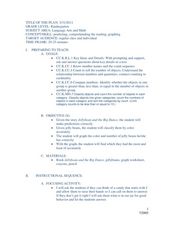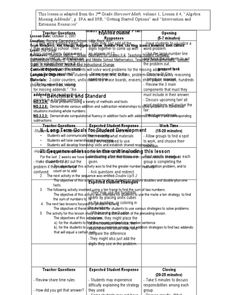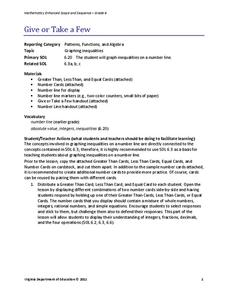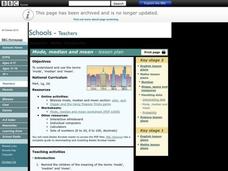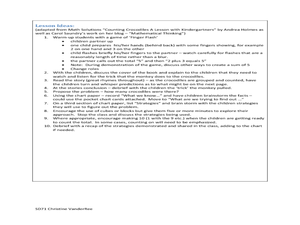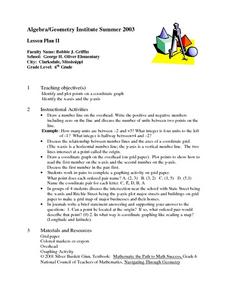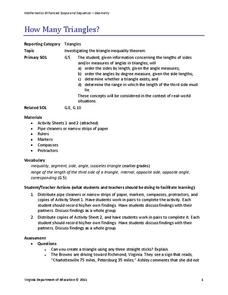Curated OER
Mighty Oaks from Little Acorns
What does it mean to grow? To germinate? For the plan detailed here, class members investigate the growth process of an oak tree while focusing on the beginning stages of planting and germination. They plant seeds and record observations...
Curated OER
The Jellybeans and the Big Dance
Enchant your youngsters by reading them The Jellybeans and the Big Dance, by Laura Numeroff and Nate Evans. Ask them to name objects that begin with the letter J like jellybeans. Give each of them some jellybeans to sort by color....
Curated OER
Teenagers
In this fast-paced activity, learners identify the order of numbers from 13 to 20. They practice greater than and less than with verbal responses to pairs of numbers. Suggested accompaniments include counting forward and backward to 20....
Curated OER
The Real Number System
Learners analyze the real number system. They discuss real numbers, rational and irrational numbers, integers, whole numbers, natural numbers and more of the real number in the system. They differentiate between all these numbers.
Curated OER
Math Lesson Study Plan
Second graders find missing addends by solving math word problems. In this missing addend lesson, 2nd graders work in a whole group setting to find the missing addends in word problems before using the strategies to work independently....
Perkins School for the Blind
Integrated Skills - Laundry
I hate doing laundry, even if it is an independent living skill that requires me to count money, follow a sequence, and sort clothing by color. Learners with multiple disabilities discuss what laundry is, why they need to do it, and how...
Education World
Teaching Students to Tell Time: Three Resources for Busy Teachers
Elementary schoolers develop time-telling skills, one skill at a time. They examine the connection between time on digital and analog (clock-face) clocks. An excellent lesson on teaching how to tell time!
Curated OER
Mitten Mania
Youngsters listen to the classic Jan Brett book, The Mitten, then gain strength in utilizing listening skills, developing vocabulary, practicing sequencing events, and expressing themselves through movement and art projects. This rich...
Curated OER
Zero is Our Hero
Students practice counting sets of items by 10's. In this counting lesson, students create flash cards that show a zero while hiding the first number in order for students to practice counting by 10's. Students practice...
Curated OER
Area Under A Curve
Calculus students use the derivative and integral to solve problems involving areas. They calculate the area under a curve as they follow a robot off road making different curves along the drive, using Riemann Sums and...
Virginia Department of Education
Analyzing and Interpreting Statistics
Use measures of variance to compare and analyze data sets. Pupils match histograms of data sets to their respective statistical measures. They then use calculated statistics to further analyze groups of data and use the results to make...
Curated OER
Geometric & Arithmetic Patterns
Eighth graders explore sequences. They discuss the difference between an arithmetic sequence and a geometric pattern. Students participate in workstation activities where they determine arithmetic or geometric patterns and predict the...
Virginia Department of Education
Give or Take a Few
Young mathematicians extend their knowledge of rational numbers on a number line to graph inequalities by first using number cards to compare rational numbers. They finish by using similar reasoning to graph inequalities on a number line.
Curated OER
The Dragon Curve Fractal
Learners identify the properties of a dragon curve. In this geometry instructional activity, students identify sequences and patterns as they solve fractals. They investigate patterns found in nature.
Virginia Department of Education
Inductive and Deductive Reasoning
Introduce pupils to the two types of reasoning, inductive and deductive. Classmates work in pairs or small groups to learn the difference between the two and apply these reasonings to develop valid conclusions.
Curated OER
Mode, Median, and Mean
Students define mode, median and mean, and perform mathematical operations to determine these 3 terms. In this statistics/math instructional activity, students practice memory strategies to help distinguish between mode, median, and...
Curated OER
Book Title: Counting Crocodiles by Judy Sierra
Students explore number sequence in a variety of activities. In this number practice lesson, students play a game of finger flash and read the book Counting Crocodiles. Students discuss the counting elements in the book and chart the...
Curated OER
Telling the Time
Learners practice telling time by completing the various activities. For this telling time lesson, students view a large clock and discuss the words 'to' and 'past' the hour. Learners count in 5s using the clock and then set their own...
Curated OER
Fractal and the Dragon Curve
Students explore Fractal designs. In this geometry lesson, students observe the different polygons created in nature and relate it to math. They define polygons on planes and rotate polygons about a point.
Virginia Department of Education
Logic and Conditional Statements
If there is a conditional statement, then there is a hypothesis and conclusion. Pupils learn how to identify the parts of conditional statements. Class members continue to work with conditional statements and rewrite them in their many...
Curated OER
Graphing Coordinates
Sixth graders practice graphing coordinates. In this geometry lesson plan, they use the x and y axis to locate points that must be connected in the right sequence to form a straight line.
Curated OER
Counting to 15
In this counting worksheet, students count from given numbers to given numbers, filling in the missing numbers in each sequence. Worksheet uses numbers 1-15. A reference web site is given for additional activities.
Virginia Department of Education
Lines and Angles
Explore angle relationships associated with transversals. Pupils construct parallel lines with a transversal and find the measures of the angles formed. They figure out how the different angles are related before constructing...
Virginia Department of Education
How Many Triangles?
Something for young mathematicians to remember: the sum of any two sides must be greater than the third. Class members investigates the Triangle Inequality Theorem to find the relationship between the sides of a triangle. At the...

